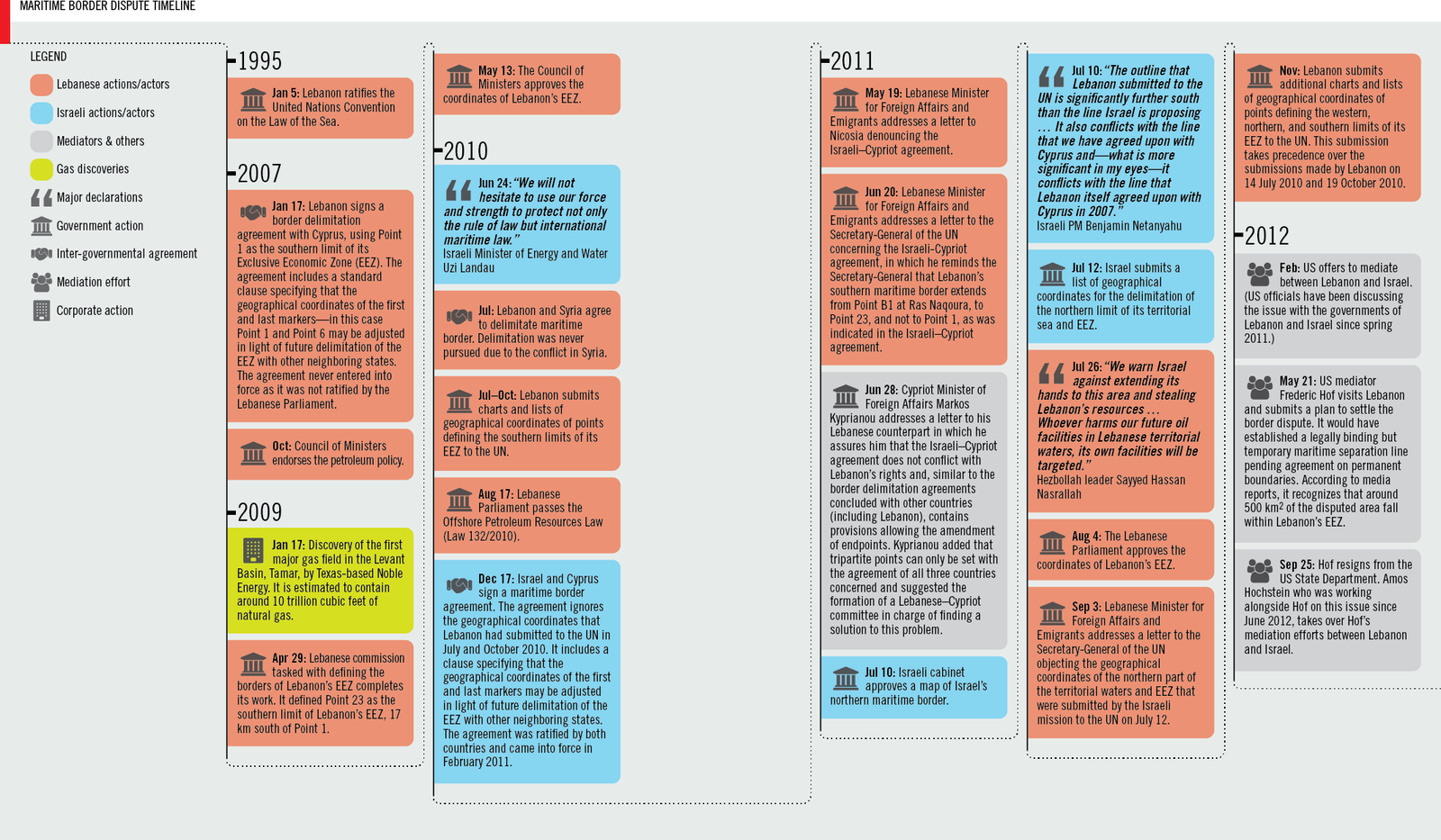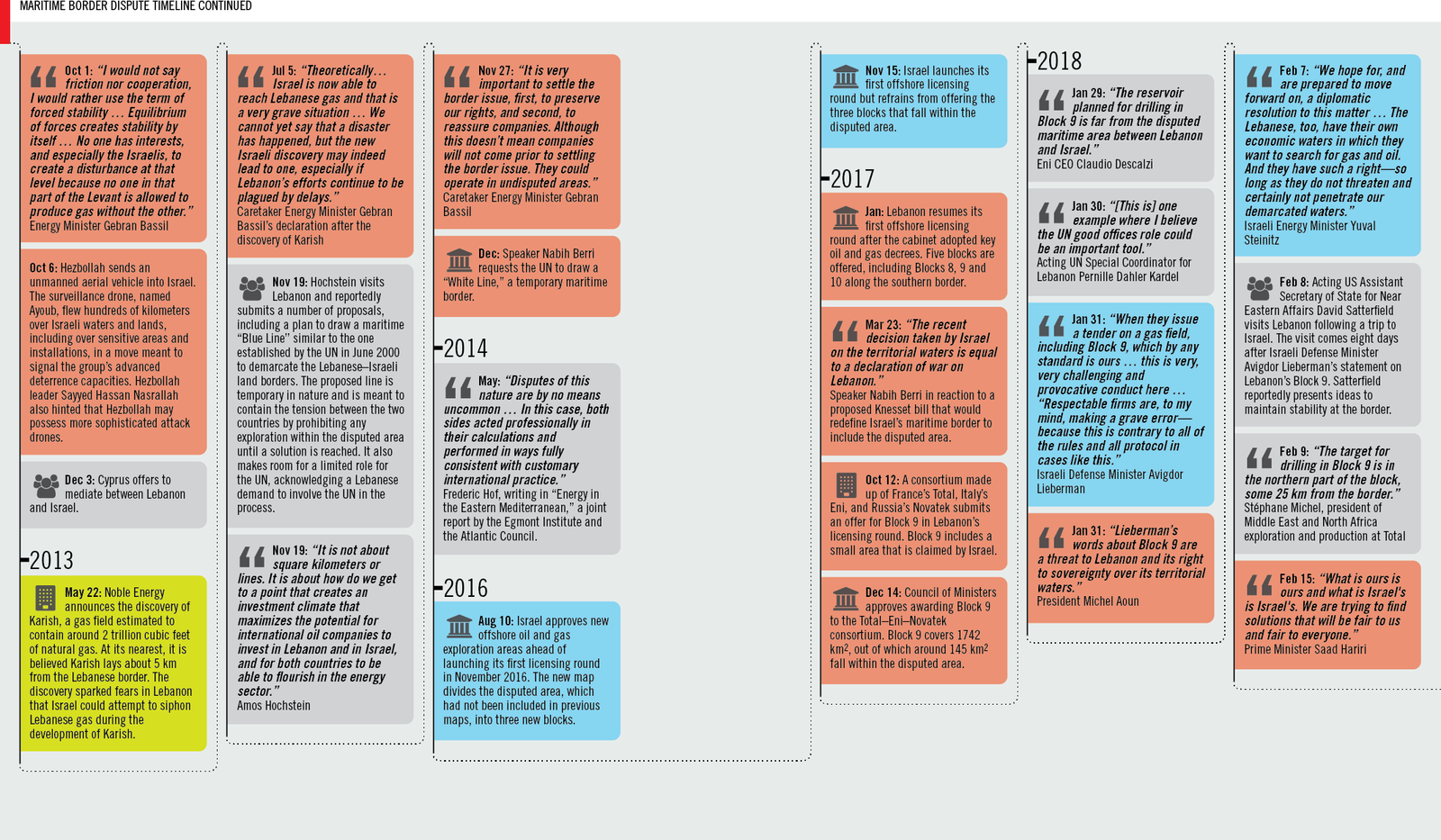The comments made by Israel’s Defense Minister Avigdor Liberman at a Tel Aviv conference on January 31 sparked outrage in Lebanon. It brought the issue of the maritime border dispute between Lebanon and Israel back into the spotlight and managed to catch Washington’s attention once again.
Little was happening on this front after the change of Administration in the U.S. After a few months, Lebanese officials stopped announcing that a resumption of mediation efforts was imminent. Then, in October, the decision, by a Total-led consortium to place a bid for Block 9 (which includes a disputed area) in Lebanon’s first licensing round, rekindled interest once again in the topic. But the buzz was discreet, confined to experts and diplomatic circles, until it was out in the open when Liberman described Lebanon’s offshore tender as “very provocative” and urged international companies not to bid, about a month and a half after licenses were awarded (see our roadmap).
The dispute unfolded in December 2010, when Cyprus and Israel signed a maritime border agreement that was denounced by Lebanon because it encroached on parts of its Exclusive Economic Zone (EEZ). On July 10, 2011, the Israeli cabinet approved a map of Israel’s northern maritime border, and two days later, the Israeli mission to the United Nations submitted a list of geographical coordinates for the delimitation of the northern limit of Israel’s territorial sea and EEZ. Some of the points defined in the Cypriot-Israeli agreement and submitted later to the U.N. overlap with the Lebanese EEZ.

But to understand how we got here, we must go back to 2007. On January 17 of that year, Lebanon signed a maritime border agreement with Cyprus. It followed standard procedure outlined in the UN Convention on the Law of the Sea (UNCLOS), marking a series of points that are equidistant from Cyprus and Lebanon (median line). Point 1 was used to mark the southernmost point along this line, while Point 6 marked its northernmost point. The agreement included a standard clause specifying that the geographical coordinates of the first and last markers, in this case Point 1 in the south, and Point 6 in the north, may be adjusted in light of future delimitation of the EEZ with other neighboring States, since a bilateral agreement cannot pretend to define the borders of third states.
The agreement was never ratified by the Lebanese Parliament, largely because of pressure from Turkey, which denounces all maritime border agreements signed by the Republic of Cyprus with its neighboring countries. As such, the agreement never entered into force.
But it wasn’t until April 2009 that a Lebanese commission tasked with defining the coordinates of Lebanon’s EEZ completed its work, identifying Point 23, 17 km south of Point 1, as the southernmost point of the EEZ. The coordinates were approved by the cabinet on May 13, 2009, and by the Parliament on August 4, 2011. In accordance with UNCLOS, Lebanon submitted the relevant charts and lists of coordinates to the U.N. in July and October 2010 and in November 2011. Just like the Israeli submissions mentioned above, these are unilateral submissions and do not amount to border delimitation. Israel objects to the southernmost coordinates submitted by Lebanon. Less known is the fact that Syria also objected to the delineation provided by Lebanon in a letter transmitted to the U.N. Secretary-General on 15 July 2014, saying that it does not have “any binding legal effect on other States. It remains only a notification, and one to which the Syrian Arab Republic objects”.
The obvious question is: Why has Lebanon signed a border agreement with Cyprus in 2007, more than two years before it had a precise definition of the borders of its EEZ?
While the Lebanon-Cyprus agreement was never ratified and did not reflect Lebanon’s final position on the southern boundary of its EEZ, it did provide Israel an opening. In December 2010, Israel signed a similar maritime border agreement with Cyprus. This deal ignored the coordinates that had been declared by Lebanon and sent to the UN a few months prior, instead using Point 1, the southernmost marker referenced in the 2007 Lebanese-Cypriot agreement, as the northernmost marker in the Israeli-Cypriot agreement. It allowed Israeli Prime Minister Benjamin Netanyahu to say in July 2010 that “the outline that Lebanon submitted to the UN (…) conflicts with the line that we have agreed upon with Cyprus and – what is more significant in my eyes – it conflicts with the line that Lebanon itself agreed upon with Cyprus in 2007”.
Of course, the Israeli-Cypriot agreement, like the Lebanese-Cypriot agreement before it, includes the standard clause specifying that the geographical coordinates of the first and last markers may be adjusted in light of future delimitation of the EEZ with other neighboring States. This left room to maneuver.
The overlap is over a triangle around 856 km2 in size that widens as it goes further out to sea. According to Frederic Hof, the first U.S. mediator, disputes of this nature are common and “both sides acted professionally in their calculations and performed in ways fully consistent with customary international practice”.

Israel is not a signatory to UNCOLS. And, because of the situation between Lebanon and Israel, a third-party mediation was the optimal choice to try to find a solution to the dispute. Cyprus offered its services a couple of times, but it finally settled on the Americans. The first mediator, Frederic Hof presented a plan in May 2012 creating a provisional but legally binding maritime separation line and a buffer zone with no petroleum activities. According to media reports, it acknowledged that around 500 km2 of the disputed area belong to Lebanon. It didn’t satisfy Beirut but was neither approved nor officially rejected at the time.
Amos J. Hochstein, the Deputy U.S. Assistant Secretary of State for Energy Diplomacy, took over Hof’s mediation efforts at the end of 2012. In Beirut, it was seen as an opportunity to put Hof’s plan aside and seek more favorable proposals. In November 2013, Hochstein reportedly submitted to Lebanese officials a plan to draw a maritime “blue line” similar to the one established by the U.N. in June 2000 to demarcate the Lebanese-Israeli land border. The line would be temporary in nature and meant to contain tension between the two countries by prohibiting any exploration within the disputed area until a solution is reached. It also makes room for a limited role for the U.N., acknowledging a Lebanese demand to involve the U.N. in the process. It was seen as a good starting point in Lebanon but was not met with enthusiasm in Israel. Frequent power vacuums in Lebanon didn’t help. By the time Lebanon had fully functioning institutions, with a new President in Baabda in October 2016 and a new cabinet in December 2016, we were only weeks away from the end of the Obama administration, which also brought an end to Hochstein’s mediation. The Trump administration had other priorities and didn’t actively involve itself on the subject until lately. A week after Liberman’s comments, Acting U.S. Assistant Secretary for Near Eastern Affairs David Satterfield visited Lebanon in preparation to Secretary of State Rex Tillerson’s visit to Beirut on February 15. The U.S. appeared to be dusting off a proposal based on the Hof plan and Beirut was not thrilled. Lebanon prefers to involve the U.N. and made a counter-proposal to demarcate the border via a trilateral committee including Lebanese, Israeli and U.N. representatives in addition to experts and American diplomats. A procedure that is similar to the one used in 2000 to demarcate the land border known as the Blue Line. The offshore extension is now being referred to as the White Line. But both the U.S. and Israel prefer to keep any U.N. role minimal.
For now, there is a sense in Beirut that there is no urgency that justifies going with plans that are deemed unfavorable to Lebanon, now that Block 9 has been awarded and an actual escalation is ruled out given that it is supposedly not in the interest of any party. The awarding of Block 9 and upcoming exploratory activities within it were what triggered the Israeli comments at the end of January. But Block 9 covers 1742 km2, out of which around 145 km2 (around 8%) fall within the disputed area. At the official signing ceremony for the exploration and production agreement on February 9, Total’s Stéphane Michel confirmed that the company’s target for drilling in Block 9 is going to be in the northern part of the block, some 25 km away from the disputed border. It is hoped that this would contain tension and allow the company to proceed with its work undisturbed. But will it be enough? Total has committed to drilling at least one well in Block 9. Failing to drill will incur a penalty worth millions of dollars. But that’s not uncommon when a company estimates that a penalty is less costly than going ahead. In fact, in early 2015, just before the discovery of Zohr reignited interest in the region, Total failed to proceed with its commitments in Cyprus and relinquished Block 10 without drilling any well.
This article was written for the March 2018 edition of Executive Magazine.
